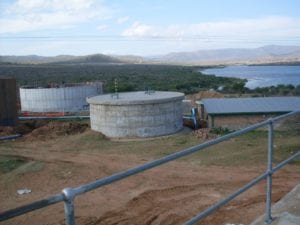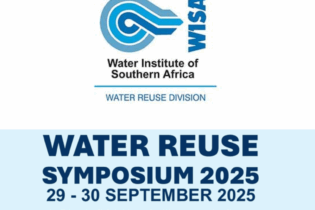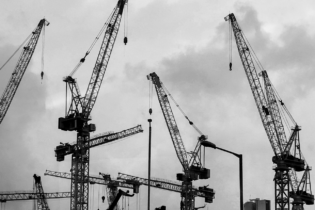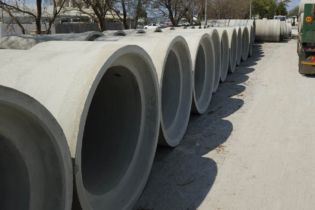The upgrade of the Molepo Regional Water Scheme includes the refurbishment of the existing 160kℓ storage facility and the construction of a 1.5Mℓ reinforced concrete reservoir. IMIESA takes a look at the technical details of this project.
The Molepo Regional Water Scheme serves 10 116 households, and due to the increased water demand, Polokwane municipality commissioned the upgrade of the scheme, which consists of the following sections:•upgrading of the existing water treatment works (WTW) including construction of a new sand filter and refurbishment of the two existing sand filters as well as upgrading of flocculants dosing and chlorination system
•refurbishment of the existing 160kℓ storage facility (lining and concrete repair work)
•the preparation (excavation) of a level platform for the reservoir
•construction of a 1.5Mℓ reinforced concrete reservoir complete with inlet, scour and outlet valve boxes as well as level control
•electrification and refurbishment of a borehole at Makatjane village. Area overview
The Molepo Regional Water Scheme is situated some 35 km east of Polokwane, off the Polokwane – Tzaneen tar road (R71). It is further linked by rural gravel roads in and around the Zion City Moria.
The proposed project is being supplied with water from the existing Molepo Dam, which has a yield of 6Mℓ/day. The capacity of the WTW is 972Kℓ/day, which is lower than the projected total water demand of 6Mℓ/day for the supply area. The supply area will extend to the Laastehoop Regional Water Scheme to alleviate the load on the Ebenezer supply scheme. The present average groundwater supply as per the feasibility report is 790kℓ/day. The boreholes will be used to supplement and act as back up to the proposed water supply through the Molepo Dam. The ultimate bulk supply to the project area will comprise of a western and eastern bulk supply. The following components will form part of the bulk supply infrastructure: INFRASTUCTURE DETAIL STATUS
A western bulk supply pipeline of approximately 2 km
Existing infrastructure
An eastern bulk supply pipeline of approximately 6 km
Existing infrastructure
Three booster pumps at existing Molepo WTW
Existing infrastructure
One 2 Mℓ command reservoir on the western bulk supply pipeline Existing infrastructure
One 1 Mℓ command reservoir on the eastern bulk supply pipeline Existing infrastructure The bulk distribution to the villages is via the western and eastern bulk distribution pipelines. The proposed western distribution pipeline will be connected to the Western Command Reservoir and the eastern distribution pipeline to be connected to the Eastern Command Reservoir. The following components will form part of the infrastructure along the distribution pipelines:
•a western bulk distribution pipeline of approximately 39 km
•an eastern bulk distribution pipeline of approximately 7 km
•five village reservoirs along the eastern bulk distribution pipeline
•twelve village reservoirs along the western bulk distribution pipeline
•village reticulations to supply residents with water to RDP level of service. Table 1: The project villages to be supplied by the proposed eastern and western bulk distribution pipelines
Villages connected to the eastern bulk distribution
1 Ga-Molalemane 4 Mamatsha
2 Ga-Molepo 5 Maripathekong
3 Makubung
Villages to be connected to the western bulk distribution
6 Bethel 12 Ditlhopaneng
7 Ga-Lekgothoane 13 Makatiane
8 Ga-Mogano 14 Marobo
9 Ga-Ramphere 15 Sebyeng
10 Ga-Sebati 16 Sekgweng
11 Lekgadimane 17 Tsebela Table 2 shows the projected 2010 water demand of the village that will be connected to the western and eastern bulk distribution pipelines. A unit consumption rate of 60ℓ/c/d has been used to calculate the design flow within the bulk distribution pipelines. Table 2: Water demand of areas to be connected to the eastern and western bulk distribution pipelines. The 2015 summer water demand of the eastern and western bulk distribution supply areas over 24 hours is 13.03 ℓ/s and 18.65 ℓ/s respectively
Area Population AADD
(Kℓ/d) GAADD
(Kℓ/d) SPD
(Kℓ/d) DPF
(ℓ/s) DPFR – bulk over 20 hrs
(ℓ/s)
Eastern villages
Ga-Molamelane 316 18.9 21 0.289 0.723 0.35
Ga-Molepo 2,851 179.8 198 2.747 6.866 3.30
Makubung 1,034 65.2 72 0.996 2.491 1.20
Mamatsha 4,391 276.9 305 4.231 10.577 5.08
Maripathekong 2,691 169.7 187 2.593 6.481 3.11
Eastern villages
sub total 11,283 710.5 782 10.855 27.139 13.03
Western villages
Bethel 661 39.7 44 0.606 1.516 0.73
Ga-Lekgothoane 1,774 106.4 117 1.626 4.065 1.95
Ga-Mogano 661 39.7 44 0.606 1.516 0.73
Ga-Rampheri 296 17.8 20 0.272 0.679 0.33
Ga-Sebati 3,777 226.6 249 3.462 8.656 4.15
Lekgadimane 1,316 79.0 87 1.206 3.016 1.45
Dihlopaneng ,2913 174.8 192 2.670 6.675 3.20
Makatiane 1,289 77.3 85 1.182 2.954 1.42
Marobo 1,176 70.6 78 1.078 2.696 1.29
Sebyeng 1,176 70.6 78 1.078 2.696 1.29
Sekgweng 1,478 88.7 98 1.355 3.388 1.63
Tsebela 439 26.4 29 0.403 1.007 0.48
Western villages
sub total 16,959 1,017.5 1,119 15.545 38.864 18.65 Water treatment works In the Molepo Supply Scheme feasibility report, the capacity of the treatment works was found to be 972Kℓ/day. The anticipated maximum capacity of the Molepo WTW is 6Mℓ/day and therefore requires an upgrade to accommodate the increase in future water demand. Currently there are three existing sand filter units at the WTW of which only two are operational. There is also an additional existing unit which is currently not equipped. In order for the WTW to meet the water demand of 6Mℓ/day, the WTW will have to be upgraded in a multi-year project cycle. The first phase will only concentrate on increasing the capacity of the plant to approximately 1.9Mℓ/day and the storage capacity to approximately 1.9Mℓ/day. Capacity from the source
The yield of the Molepo Dam is reported to be approximately 6.2Mℓ/day and the capacity of the plant at the end of the first phase will be approximately 1.9Mℓ/day, which leaves a spare capacity of approximately 4.3 Mℓ/day. Once the WTW has reached its maximum capacity of 6Mℓ/d, the additional water will be supplied via Ga-Sebati to the Laastehoop and Ga-Mojapelo Reserve Water Schemes to alleviate the load on Ebeneza and maximize the utilisation of existing water sources. The existing water related infrastructure within the supply area of the western and eastern bulk distribution pipelines consists of the following key components:
• Molepo Dam
• Molepo WTW with three booster pumps and a 200kℓ storage
• various distribution pipelines
• twelve village reticulations
• 13 storage reservoirs of varying sizes
• command reservoirs (1Mℓ and 2Mℓ).
Table 3: Overview of project design guidelines
GENERAL GUIDELINES Maximum static head (village reticulation) 90 m maximum, below 60m preferredMinimum reticulation residual head 10m at point of delivery, flow limiters to be installed on standpipes when residual pressures are greater than 25m above GL
Minimum/maximum linear flow velocity under domestic peak flow conditions 0.3 to 1.5 m/s and 3 m/s maximum in bulk supply pipelines
Pipe type uPVC to SABS 966 Part 1 and HDPE to SABS ISO 4427
Minimum pipe class (gravity pipes) 900 kPa pipe class working pressure
Minimum pipe class (pump lines) 1 200 kPa pipe class working pressure
Minimum pipe size 90 mm uPVC for village reticulations and 110 mm uPVC for bulk supply lines with a view for future village growth
Non standard sizes 125 mm 140 mm are not to be used
Consumer off-takes Not allowed directly from bulk lines
Isolating valves Isolate sections not exceeding 350 m in reticulations. Valves also at branch lines and at each standpipe
Scour valves Between isolating valves of bulk supply lines at local low points, preferably adjacent to natural streams
Air valves (double orifice) At local high points. At maximum 600 m on intervals on pump lines and maximum 1 000 m on gravity lines
Design pumping period 24 hours/day (electrical pumps)
Pump standby provision 100% for single sets, 33% for larger sets
Flow formula D’arcy Weisbach
Boundary roughness (k-value) 0.1 mm for uPVC and HDPE pipes
Minimum trench depth at road crossing Pipe Ø + bedding + 1,2m Minimum trench depth otherwise Pipe Ø + bedding + 0,8m
Minimum trench width Pipe Ø + 400 mm
Minimum bedding thickness The greater of 0.10 m or one sixth of pipe diameter STORAGE GUIDELINES
Reservoir storage capacity 24 hours of AADD for gravity source
36 hours of AADD pumped from multiple sources
48hours of AADD pumped from one source
Reservoir structure Precast concrete structures or standard reinforced concrete structure
Location of storage reservoir Preferably within 1 km from village served. Ideally to be located 30 m above elevation of highest present development inside village, thereby allowing sufficient head for future expansion or increase in level of service RETICULATION GUIDELINES Standpipe design As per standard drawing
Walking distance Maximum of 200 m walking distance to standpipe
Flow rate Minimum flow rate of 10 ℓ/min/tap. Allow one tap per standpipe
Coverage 1 standpipe for 25 households or 100 people Currently there is an existing 200Kℓ storage at the WTW which is not adequate to meet the current demand, and the other 250Kℓ storage is not functional. During the 2010/2011 financial year, focus has been placed on increasing the capacity of the water treatment plant as well as increasing storage at the source. There are currently three existing booster pump stations constructed at the water treatment plant to pump water to the Western Command Reservoir and Eastern Command Reservoir. The village of Ga-Sebati is at a height which is approximately the same level as the 2Mℓ command reservoir at Ga-Rampheri. It is proposed that in future, an additional booster pump station be constructed along the western bulk distribution pipeline to provide the required pressures in order to supply the village of Ga-Sebati with water. This however will not be covered in the initial three phases. <> Financial year scope of works
2010/2011 financial year scope of works: R8 million has been budgeted for the current financial year for the implementation of the Ga-Molepo Regional Water Scheme to do the following:
•upgrading of the WTW to be fully operational at a capacity of 1.9Mℓ/day
•refurbishment and upgrading of an existing borehole at Mamatsha
•construction of a new 1.5Mℓ storage at the treatment works
•refurbishment of existing 250Kℓ storage. 2011/2012 financial year scope of works: It is estimated that R 13.6 million will be utilised to construct the following infrastructure: •an 8km of 160mm diameter bulk pipeline from Ga-Ramphere via the Reservoir at Sebyeng, extending to the western bulk distribution complete with air valves, scour valves and all fittings
•upgrading and extension of the WTW from a capacity of 1.9Mℓ/day to 3Mℓ/day. 2012/2013 financial year scope of works: It is estimated that R 9.5 million will be utilised to construct the following infrastructure:
•a 6.3km of 160mm diameter bulk supply pipeline extending to the western bulk pipeline complete with air valves, scour valves and all fittings
•upgrading and extending the WTW from a capacity of 3Mℓ/day to 3.6Mℓ/day. PROJECT TEAM
Consultant Dombo Du Plessis & Partners
Contractor Betsekgadi Community Projects
Steel reinforcement Alert Steel
Steel pipe and fittings Rare Water








